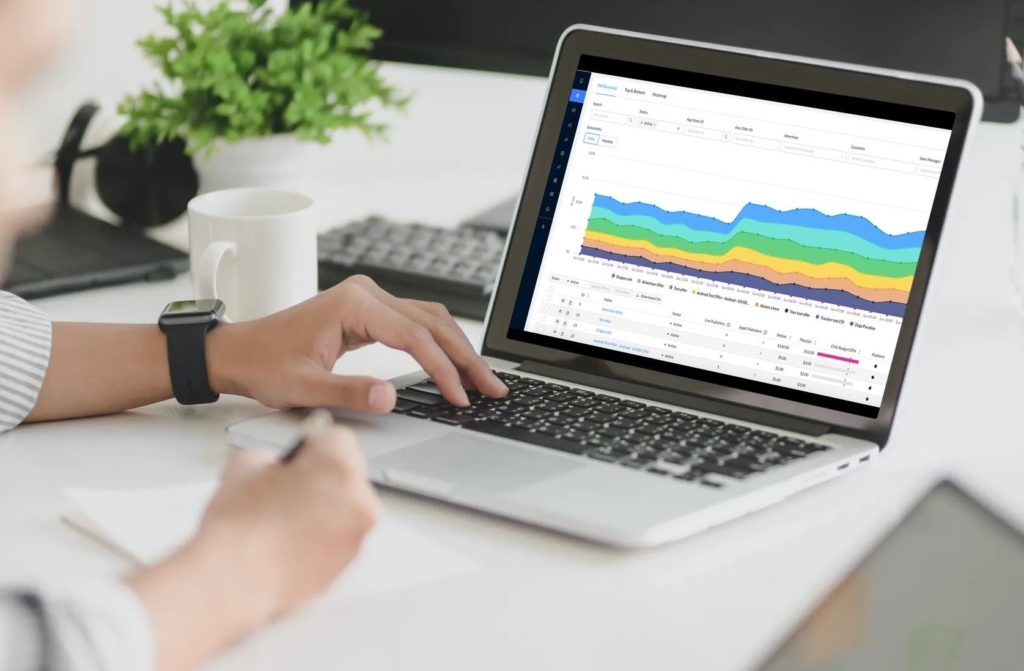Learn how to measure performance marketing campaigns in 2021
Learning how to measure performance marketing campaigns enables you to implement a data-driven approach to your overall strategy and optimize your campaigns over time. You will need to know which metrics to track and how different companies can help you achieve your goals. In this article, we define what performance marketing is, outline what is needed for the performance marketing ecosystem to function, and share which metrics can be useful to track for best results.
What is performance marketing?
The first step towards successfully measuring performance marketing campaigns is to learn what separates this type of marketing from other methods. When practicing performance marketing, advertisers pay for the number of times a desired action has been performed. For example, this could be every time a new user installs your app or every time someone clicks on your ad.
The defining factor of performance marketing is that these actions – which result in payment – are measurable. This is a different approach to other methods, such as paying an agreed amount for displaying an ad – in which case payment is not dependent on achieving the desired result. Instead, performance marketing is a goal-driven approach that gives each party their fair share while providing valuable data that can be used to optimize your strategy.
Learn more about “What are performance marketing campaigns?
There are four groups in the performance marketing ecosystem you need to know.
1. Advertisers: These marketers have a product they want to advertise and targets they want to achieve by working with publishers and affiliate marketers. For example, this could be mobile marketers looking for inventory they can use to drive installs for their new mobile game.
2. Publishers: This is a business that has inventory that can be used to display ads and reach your target audience. This includes everything from website display ads to other mobile apps that agree to give their audience impressions of your ads. Affiliate partners are also included with this term.
3. Tracking platforms: Advertisers can gather data using third-party tracking platforms for several reasons. This is a critical step because it enables you to track and measure performance marketing metrics, which is needed to complete payments to your publisher/affiliate partner. Tracking platforms and the data they enable you to gather are also powerful tools for optimization and developing your overall strategy.
4. Affiliate managers: This term includes in-house managers who are working for an advertiser’s team, but it can also be a specialist who has been hired by the advertiser. It is the affiliate manager’s job to connect the advertiser to affiliate networks, identify ways advertisers can optimize their strategy, and improve the performance of their campaigns.
Performance marketing is mutually beneficial for every group involved within its ecosystem. This is because paying for completed actions means advertisers can act with confidence and be sure they are getting a fair deal. An additional benefit for advertisers is the free brand exposure to users that do not click on the ad or complete a desired action.
How to measure performance marketing campaigns
Due to the nature of performance marketing campaigns and their payment model, a measurable goal is a critical requirement. This means advertisers must work with tracking platforms to track the data they need in order to successfully measure performance marketing campaigns. Your tracking platform will also provide a dashboard that can be used for data analysis and strategic decisions related to your campaigns.
When setting up your campaigns with a tracking platform you must determine which metrics are relevant to you and your goals. This includes the metrics relevant to your payment model and anything else that may be insightful and lead to a better understanding of your audience.
Popular performance marketing metrics include the following:
- Leads: How many leads were generated as a result of your publishers’ and affiliate partners’ exposure? Tracking the number of leads will show how effective each campaign is for acquiring high-value customers.
- Impressions: This is when a user is served an ad via a publisher’s inventory.
- Installs: This is the number of users who have installed the advertiser’s mobile app as a result of being served an impression. You can track other metrics (such as in-app purchases and invites) to learn the long-term value of these customers, revealing how much revenue is generated over time as a result of each campaign.
- Conversions: A conversion can mean any action that converts the user to complete the desired result. For example, a conversion can be the completion of an in-app purchase, an install, or a click-through to the app store.
Marketers may also want to track these critical metrics to gain valuable insights:
- Churn: This is how many users have stopped using your mobile app after a defined period of time. For example, you can track and measure churn for Day 1, Day 7, or Day 30 to see when users are losing interest. Tracking churn is also needed for measuring Lifetime Value (LTV).
- Retention rate: This is the opposite of churn, measuring the number of users who still use your app after a defined time period – such as Day 1, Day 7, or Day 30.
- Return on Ad Spend (ROAS): This is how much revenue is generated as a direct result of your ad spend.
- Return on Investment (ROI): This is the ratio of profit (or loss) on your investment.
The data you have tracked will be available on your tracking platform’s dashboard, or you can export data to use with your own BI system. When working with tracking platforms and publishers, there are several ways your measurements can be used to optimize performance. For example, audience targeting enables marketers to select the type of user they want to be exposed to their ads. This is defined using filters such as demographic and geographical location, which can be adapted based on the results of previous campaigns.
Learn more about “What makes a good performance marketer”
Measuring performance marketing metrics: How Swaarm can help
We have created a tracking platform that is designed to make actions faster and easier for marketers to execute. This has been achieved through a series of innovations, such as:
- Marketing automation: Our platform manages more than 30 billion events per day and we are using automation to help you optimize your operations. For example, we offer tools that can approve offers and turn off traffic sources that are underperforming according to your parameters.
- Instant reporting insights: Clients can query billions of real-time events using drag and drop actions – saving you time and enabling faster data-driven decision-making. Our data science tools also enable you to run SQL and Python notebooks across your real-time and historical data. This is all performed without setup time or third-party fees.
- Optimized migration: Switching to Swaarm has been optimized to provide a seamless migrant process. This is because we have adapters that fill our platform with your information. We also have a team of experts devoted to making the process as easy as possible, available to help you at every step.
- Fraud prevention: We have automated fraud prevention technology that allows our clients to spend less time on monitoring campaigns. Our integrated click and postback shield gives clients full control over their traffic, including the ability to filter events in real-time.
- Platform stability: Data integrity is at the core of Swaarm’s business model, ensuring that your data is kept safe with the highest level of platform stability.
Learn more about “How Automation Will Streamline Performance Marketing”
Conclusion
Learning how to measure performance marketing campaigns gives you the power to make data-driven decisions and optimize your campaigns over time. A measurable result is the defining factor of performance marketing, meaning advertisers get a fair price according to the success of each campaign.
Advertisers can work with tracking platforms to track the data they need to successfully measure performance marketing campaigns. Your tracking platform will also provide a dashboard for data analysis. Popular performance marketing metrics include leads, installs, and conversions.
Swaarm can help you measure your performance marketing campaigns. We are a tracking platform that offers innovative automation, instant reporting insights, fraud prevention technology, and the highest level of platform stability.







